Astronomy: Gaining Perspective
VENUS
Mean Distance from the Sun: 108,200,000 km
Size: 1 Earth
Equatorial Radius: 6,051.8
Rotational period (days): 224.7
Orbital Period (days): 243
Mean Surface Temperature: 482°C
Most Abundant Elements: Carbon Dioxide (96%), Nitrogen (3%)
Moons: none
Description
Overall Characteristics
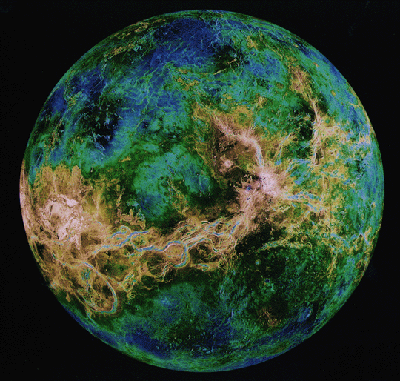
Jovian planets are also known as gas giants.
Mean Distance from the Sun: 778,330,000
Size: ???? Earths
Equatorial Radius: 71,492
Rotational period (days): 0.4
Orbital Period (days): 4332.7
Mean Cloud Temperature: -121°C
Most Abundant Elements: Hydrogen (90%), Helium (10%)
Moons: Metis (1979), Adrastea (1979), Amalthea (1982), Thebe (1979), Io (1610), Europa (1610), Ganymede (1610), Callisto (1610), Leda (1974), Himalia (1904), Lysithea (1938), Elara (1905), Ananke (1951), Carme (1938), Pasiphae (1908), Sinope (1914), and 12 Additional Satelites discovered in 1999 and 2000.
Description

Jupiter’s Moons – The moon’s Io, Europa, and Ganymede all orbit around Jupiter’s equator, leading astronomers to believe they formed out of left over material from the planet’s formation. Io is of interest to astronomers for its fantastic volcanic activity. Europa is of interest for the liquid water suspected to exist beneath its icy surface, where some scientists hypothesize life could form around volcanic vents as it does on Earth.
SATURN
Mean Distance from the Sun:
Size: Earths
Equatorial Radius: 60,268
Rotational period: 10.2 Hours
Orbital Period: 29.458 years
Mean Cloud Temperature: -125°C
Most Abundant Elements: Hydrogen (97%), Helium (3%)
Moons: Pan (1990), Atlas (1980), Prometheus (1980), Pandora (1980), Epimetheus (1966), Janus (1966), Mimas (1789), Enceladus (1789), Tethys (1684), Telesto (1980), Calypso (1980), Dione (1684), Helene (1980), Rhea (1672), Titan (1655), Hyperion (1848), Iapetus (1671), Phoebe (1898), and 12 New Satelites found in 2000.
Description
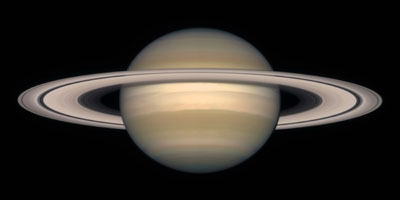
Saturn’s Moons – Prometheus and Pandora keep one of Saturn’s rings in place by herding the material there with gravity. Pandora orbits the outside of the ring, Prometheus on the inside. Scientists have been unable to predict the orbits of these two moons, which vary widely over time, leading astronomers to believe their orbits are chaotic. Of special interest to scientists is Titan, Saturn’s largest moon and the only moon in the solar system with thick cloud coverage comprised of organic building blocks.
Mean Distance from the Sun: 2,870,990,000
Size: Earths
Equatorial Radius:
Rotational period: 17.9 hours
Orbital Period: 84 days
Mean Cloud Temperature: -193°C
Most Abundant Elements: Hydrogen (83%), Helium (15%), Methane (2%)
Moons: Cordelia (1986), Ophelia (1986), Bianca (1986), Cressida (1986), Desdemona (1986), Juliet (1986), Portia (1986), Rosalind (1986), Belinda (1986) , Puck (1985), Miranda (1948), Ariel (1851), Umbriel (1851), Titania (1787), Oberon (1787), Caliban (1997), Stephano (1999), Sycorax (1997), Prospero (1999), Setebos (1999), and 1986U10 (1999).
Description
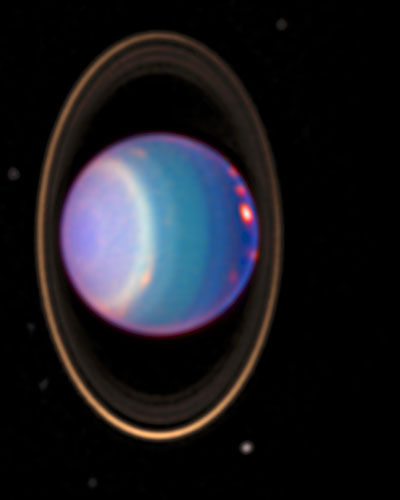
NEPTUNE
Mean Distance from the Sun: 4,504,300,000
Size: Earths
Equatorial Radius: 24,746
Rotational period: 16.11 hours
Orbital Period: 164.8 years
Mean Cloud Temperature: -193 to -153°C
Most Abundant Elements: Hydrogen (83%), Helium (13%), Methane (2%)
Moons: Naiad (1989), Thalassa (1989), Despina (1989), Galatea (1989), Larissa (1989), Proteus (1989), Triton (1846), and Nereid (1949).
Description
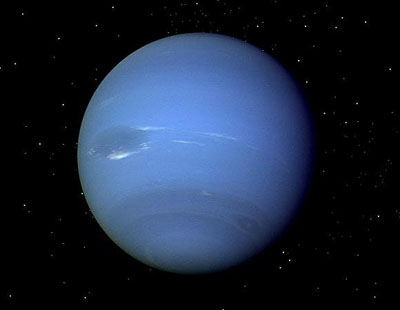
PLUTO
Mean Distance from the Sun: 5,913,520,000
Size: Earths
Equatorial Radius: 1,137
Rotational period (days): 6.4
Orbital Period: 248.5 years
Minimum Surface Temperature: -240°C
Most Abundant Elements: Methane, Nitrogen
Moons: Charon
Description
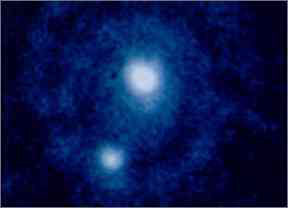
The Oort Cloud
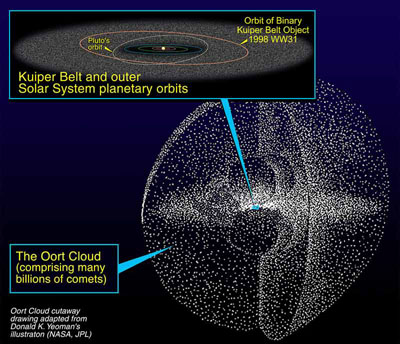
THE MILKY WAY
Stars Are Born…
Gaseous Pillars in the Eagle Nebula
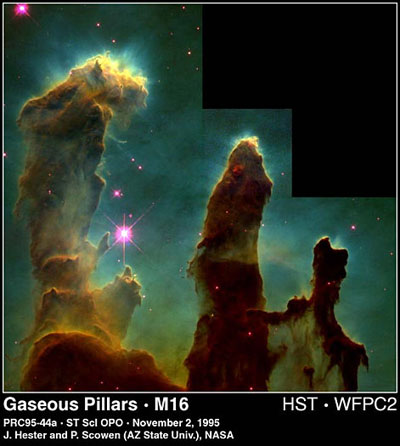
Protoplanetary Disk in the Orion Nebula
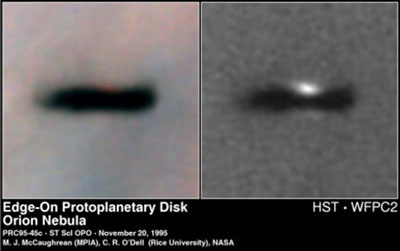
Hourglass Planetary Nebula
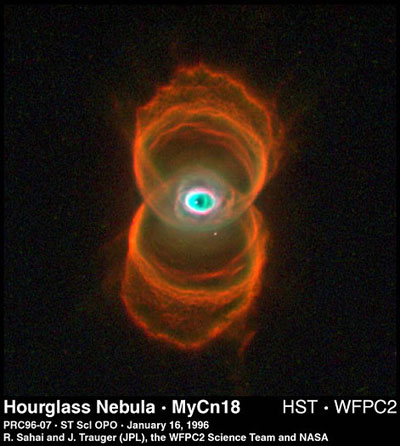
Monocerotis
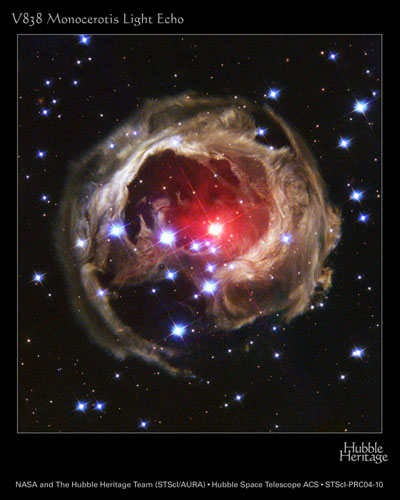
Cat’s Eye Nebula
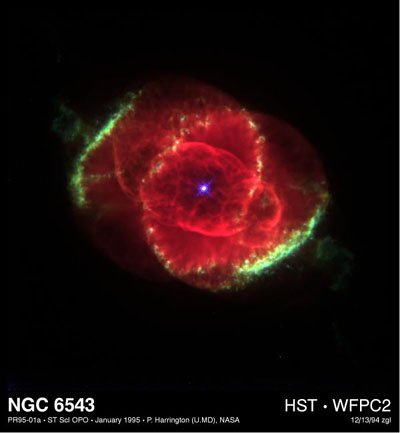
Twin Jet Nebula

A Bow Shock Near a Young Star
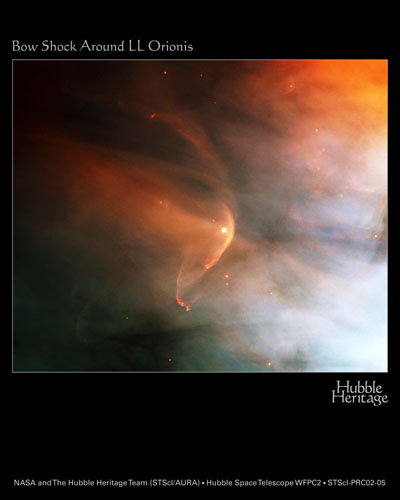
The Bubble Nebula
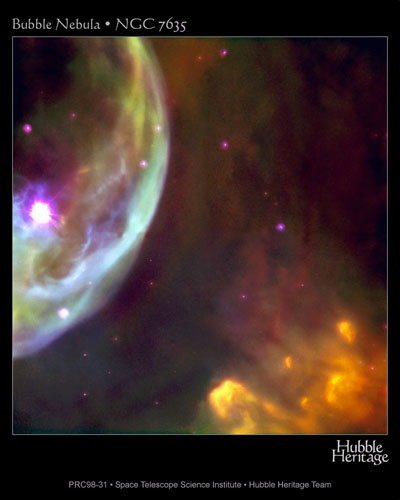
Cometary Knots

Mystery Picture

THE COSMOS:
When galaxies collide (quicktime required).
The “Sombrero” Galaxy
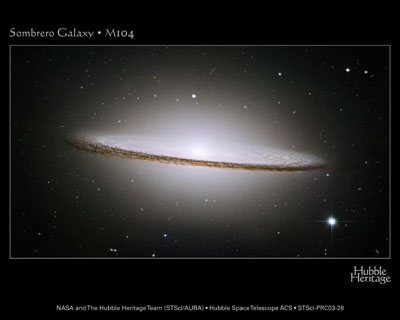
The “Black Eye” or “Evil Eye” Galaxy

The “Tadpole” Galaxy
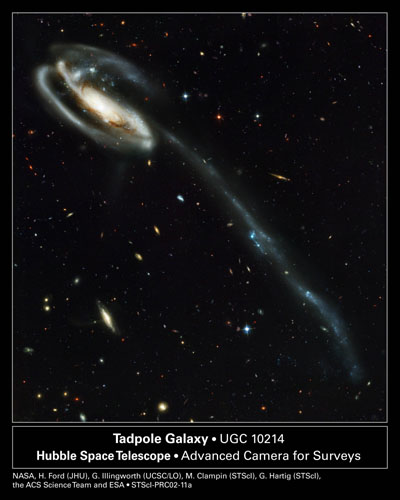
The Cartwheel Galaxy
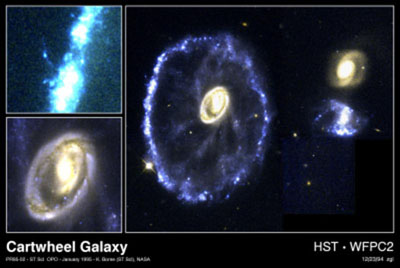
The “Backwards” Galaxy
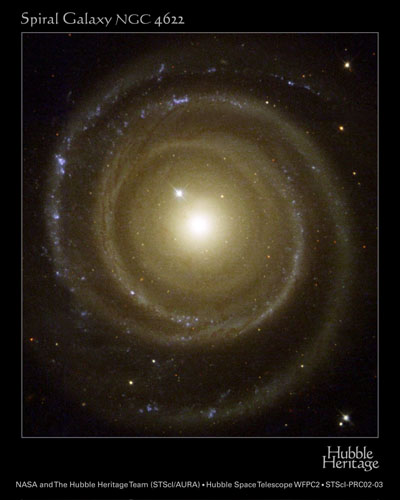
Seyfert’s Sextet
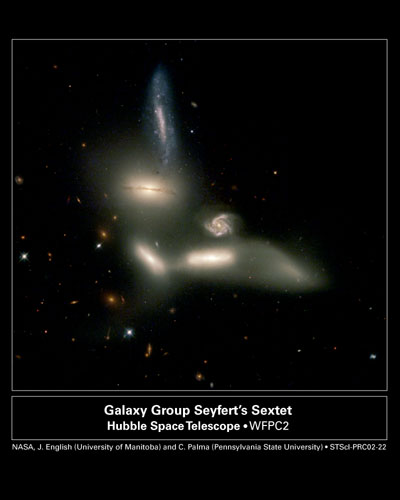
The Deep Deep Field

BEYOND....
Is there life elsewhere in the Cosmos or are we unique? Frank Drake has shed some light on this by compiling all of the chance factors that brought the human race to this point into an equation that estimates the probability of it occurring elsewhere in our galaxy.
The Drake Equation
After playing with this equation, we find a high probability that there are at least a few communicating civilization in our own galaxy. If such life exists and we have been searching the skies for it with telescopes and radio receivers, why haven’t we found it?
Fermi’s Paradox
Enrico Fermi proposed that considering the age of the Universe and providing for even a single civilization forming in our galaxy to colonize it at a steady rate, we should have encountered alien life by now. In fact, the Universe should be teeming with life.
Perhaps colonization is not the ultimate goal of civilization. Perhaps the physical dimensions of our universe is not all there is to it. Perhaps life is simply really really difficult to see? Looking at the family portrait of our solar system, how would anyone know life existed on our planet?
Another thing to consider is the exponential growth of our intelligence. It took billions of years for our ancestors to appear on the Earth. It took the human race millions of years to evolve into a basic tool-using species congregating in tribes. It then took tens of thousands of years for us to form larger societies with laws and structures of thought. A few thousand years later, we entered an industrial age. One-hundred years after that, we began our communications revolution. Within a few decades we have begun to open the doors to a genetics revolution.
We are getting smarter faster. One reason we may not have been visited by extraterrestrials is that they would find it unethical to visit us. The human race has only interacted with its more primitive cultures to take from them. What could a being with the capability of traveling hundreds of thousands of light-years possibly want to take from us, other than anonymous observations?
The Search Continues
Scientists are looking for microscopic life everywhere in our solar system now. We are searching Mars with rovers, sending satellites to Titan, planning trips to Europa, and searching our uppermost atmosphere for alien bacteria raining down on us. If we find microscopic life elsewhere, the numbers in the Drake equation will change.

First picture of a Martian?
Modern magnetotactic bacteria, showing a chain of magnetite crystals. Bottom: Chains of magnetite crystals in the Martian meteorite ALH84001
The Inner Ring
Size: 1,300,000 Earths
Equatorial Radius: 695,000 km
Rotational period (days): 25 (equator) – 36 (poles)
Minimum Surface Temperature: 5250 degree K
Maximum Surface Temperature: 5500 to 6000 degree K
Age (Billions of Years): 4.5 billion years ago
Composition: Hydrogen (92.1%), Helium (7.8%)
Description
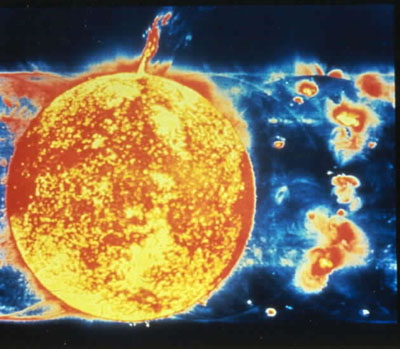
Size: 1,300,000 Earths
Equatorial Radius: 695,000 km
Rotational period (days): 25 (equator) – 36 (poles)
Minimum Surface Temperature: 5250 degree K
Maximum Surface Temperature: 5500 to 6000 degree K
Age (Billions of Years): 4.5 billion years ago
Composition: Hydrogen (92.1%), Helium (7.8%)
Description

For many, the center of our world is the Earth, but those with perspective know that it is the Sun. This ball of fusion reactions is the campfire all life on Earth huddles around. Beyond it are the shadows of the unknown.
The Sun makes up 98% of the mass of our solar system. Solar energy is created deep within its core, where the temperature (15,000,000° C; 27,000,000° F) and pressure (340 billion times Earth’s air pressure at sea level) is so intense that hydrogen atoms fuse together to form helium. This atom is about .7 percent less massive than the two hydrogens, and the difference in mass is expelled as energy and carried to the Sun’s surface. Energy generated in the Sun’s core takes a million years to reach its surface.
The Sun appears to have been active for 4.6 billion years and has enough fuel to run for another five billion years or so. At the end of its life, the Sun will start to fuse helium atoms into heavier elements and swell up, ultimately growing so large it will swallow the Earth. After a billion years as a red giant, it will suddenly collapse into a white dwarf — the final end product of a star like ours, and may take a trillion years to cool off completely.
THE TERRESTRIAL PLANETS:
Mean Distance from the Sun: 57,910,000 km
Size: 0.4 Earths
Equatorial Radius: 2,439.7
Rotational period (days): 58.6
Orbital Period (days): 87.9
Minimum Surface Temperature: -173°C
Maximum Surface Temperature: 427°C
Age (Billions of Years): ????
Atmosphere: Helium (42%), Sodium (42%), Oxygen (15%)
Moons: none
Description:
Physical Characteristics
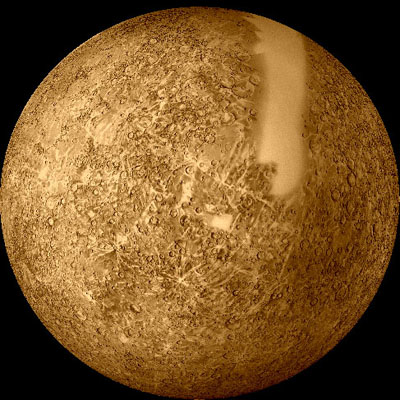
The Sun makes up 98% of the mass of our solar system. Solar energy is created deep within its core, where the temperature (15,000,000° C; 27,000,000° F) and pressure (340 billion times Earth’s air pressure at sea level) is so intense that hydrogen atoms fuse together to form helium. This atom is about .7 percent less massive than the two hydrogens, and the difference in mass is expelled as energy and carried to the Sun’s surface. Energy generated in the Sun’s core takes a million years to reach its surface.
The Sun appears to have been active for 4.6 billion years and has enough fuel to run for another five billion years or so. At the end of its life, the Sun will start to fuse helium atoms into heavier elements and swell up, ultimately growing so large it will swallow the Earth. After a billion years as a red giant, it will suddenly collapse into a white dwarf — the final end product of a star like ours, and may take a trillion years to cool off completely.
THE TERRESTRIAL PLANETS:
The Terrestrial Planets are Mercury, Venus, Earth and Mars.
- They are so-named because they are similar to the earth in size and composition.
- They are also the first four planets.
MERCURY
Mean Distance from the Sun: 57,910,000 km
Size: 0.4 Earths
Equatorial Radius: 2,439.7
Rotational period (days): 58.6
Orbital Period (days): 87.9
Minimum Surface Temperature: -173°C
Maximum Surface Temperature: 427°C
Age (Billions of Years): ????
Atmosphere: Helium (42%), Sodium (42%), Oxygen (15%)
Moons: none
Description:
Physical Characteristics
- Its diameter is 40% of that of the earth, being smaller than two moons in the solar system (Ganymede & Titan).
- Its distance from the sun is 40% of that of the earth.
- It looks like a bright star, but is so near the sun it is still hard to see.
- It is so close to the sun that it cannot be seen well in any telescope.
- It was first seen well when the Mariner 10 had a close fly-by.
- It looks a lot like the moon, covered with many craters, probably from intense early bombardment.
- Its orbital period is 88 days or about 1/4 year.
- Mercury must pass the earth 3 times each year in order to orbits 4 times per year.
- Hence, it's synodic period is about 1/3 of a year (116 days).
- It rotates on its axis in exactly 2/3 of 88-day sidereal period.
- The surface temperature is about 100 K in the dark night to 500 K in the hot day.
- Mercury has about the same density as the earth (5.5 x water), so it probably has iron core.
- It is so small, it has essentially no atmosphere.
- It has a small ice cap right at the north pole, where sun never rises.

Closest to the sun, Mercury has only a tenuous atmosphere comprised of helium atoms captured from solar winds. The planet has some of the greatest temperature extremes in our solar system between its sunside and darkside.
VENUS
Mean Distance from the Sun: 108,200,000 km
Size: 1 Earth
Equatorial Radius: 6,051.8
Rotational period (days): 224.7
Orbital Period (days): 243
Mean Surface Temperature: 482°C
Most Abundant Elements: Carbon Dioxide (96%), Nitrogen (3%)
Moons: none
Description
Overall Characteristics
- It is almost the same diameter as the earth.
- It is usually far brighter than any star.
- There are great variations in brightness as it comes near the earth, becoming a narrrow crescent.
- Because of thick cloud cover, little was known about it before space probes.
- Venus orbital period is 8/13 of a year (225 days), that is, it completes 13 orbits in 8 years.
- That means it has 13 - 8 = 5 evening/morning star cycles (synodic periods) every 8 years.
- It has a retrograde rotation on its axis, once every 243 days.
- Its atmosphere was discovered 200 years ago when it could be seen when nearly in front of the sun.
- Its thick atmosphere is near all carbon dioxide (CO2).
- The greenhouse effect causes the atmosphere to be 750 K, hotter than Mercury.
- The atmospheric pressure is over 90 times that on earth.
- The yellowish-orange clouds are made of sulfuric acid (car battery acid!).
- The upper clouds have 200 mph winds.
- The surface has almost no wind, and is free from clouds.
- The surface has been mapped by radar.
- It is covered by geologically young lava flows which resurfaced the planet recently.
- The surface features are named for women.

If there is one planet most like Hell, Carl Sagan tells us in his documentary series Cosmos, it is Venus. A planet smothered in Greenhouse gases and pressure cooked to such an extreme that the rocks are semi-liquids. This planet, the same size as ours and our closest neighbor, serves as a cautionary warning about how we should care for our own planet, lest we create a Hell on Earth.
Mean Distance from the Sun: 149,600,000
Size: 1 Earth
Equatorial Radius: 6,378.14
Rotational period (days): .9
Orbital Period (days): 365.3
Mean Surface Temperature: 15°C
Most Abundant Elements: Nitrogen (77%), Oxygen (21%)
Moons:
Description
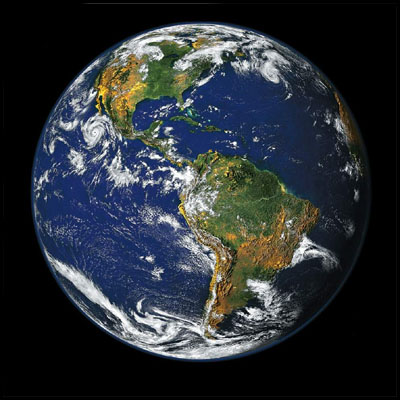
Earth’s Moon – The Earth’s moon was most likely formed out of the earth itself. Computer simulations have show that a Mar-sized object probably hit the earth, casting debris into orbit around our planet. This debris eventually collected into the inspiring object decorating our night sky. This theory accounts for the moon’s orbit, which is nearly synchronous with the Earth’s rotation, and the moon’s high iron content, similar to the composition of the Earth’s.
How the moon was made
MARS
Mean Distance from the Sun: 227,940,000
Size: 0.6 Earths
Equatorial Radius: 3,397.2
Rotational period (days): 24.6
Orbital Period (days): 687.0
Minimum Surface Temperature: -140°C
Maximum Surface Temperature: 20°C
Most Abundant Elements: Carbon Dioxide (95.3%), Nitrogen (2.7%), Argon (1.6%)
Moons: Phobos (1877), Deimos (1877)
Description
Overall Characteristics
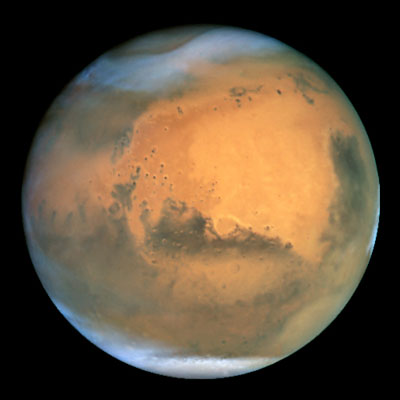
Mars has two moons, Phobos and Deimos. Phobos is getting closer to Mars every day. In about 50 million years it will either crash into Mars or be torn apart by gravity. Shreds of Phobos might then form a ring around Mars, similar to the rings of Saturn.
The Outer Ring
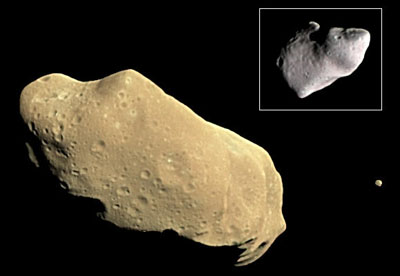
243 Ida and its satellite Dactyl.
THE JOVIAN PLANETS
EARTH
Mean Distance from the Sun: 149,600,000
Size: 1 Earth
Equatorial Radius: 6,378.14
Rotational period (days): .9
Orbital Period (days): 365.3
Mean Surface Temperature: 15°C
Most Abundant Elements: Nitrogen (77%), Oxygen (21%)
Moons:
Description

Earth’s Moon – The Earth’s moon was most likely formed out of the earth itself. Computer simulations have show that a Mar-sized object probably hit the earth, casting debris into orbit around our planet. This debris eventually collected into the inspiring object decorating our night sky. This theory accounts for the moon’s orbit, which is nearly synchronous with the Earth’s rotation, and the moon’s high iron content, similar to the composition of the Earth’s.
How the moon was made
Mean Distance from the Sun: 227,940,000
Size: 0.6 Earths
Equatorial Radius: 3,397.2
Rotational period (days): 24.6
Orbital Period (days): 687.0
Minimum Surface Temperature: -140°C
Maximum Surface Temperature: 20°C
Most Abundant Elements: Carbon Dioxide (95.3%), Nitrogen (2.7%), Argon (1.6%)
Moons: Phobos (1877), Deimos (1877)
Description
Overall Characteristics
- It is red because of the high iron oxide (rust) content of the rocks (like Bryce Canyon).
- It sometimes looks like a bright red star, but can vary a lot in brightness.
- Surface markings and the ice cap were visible in earth-based telescopes.
- It has seasons like the earth, which are about twice as long as earth's seasons.
- People thought they saw canals on the surface of Mars.
- The sidereal period of Mars is a little less than 2 years.
- Hence, the synodic period of Mars is a little more than 2 years.
- Its rotational period on its axis is almost exactly the same as the earth's (1 day).
- It is tipped on its axis about the same amount that the earth is.
- The sky is reddish due to blowing dust.
- The atmosphere, like Venus, is nearly all carbon dioxide (CO2).
- The atmospheric pressure is only 1% of that on earth.
- Temperatures ranges from -120° at night to -20° in the daytime.
- The ice cap is mostly water, covered with dry ice in the winter time.
- There are many dry river beds.
- The canals turned out to be windblown dust deposits.
- It also has many large impact craters.
- It has the largest volcanoes in the solar system.
- Olympus Mons is 78,000 feet tall.
- The base is as large as Missouri.
- Its top is as large as Los Angeles.
- No life of any kind has been found on Mars.
- Those who thought that life evolves easily from water were disappointed.
- There is no evidence that there has ever been life of Mars.
- Mars has two tiny moons discovered by A. Hall in 1877.
- They are named Phobos and Deimos (Fear and Terror) after the chariot horses of the god Mars.
- The are so small (20 & 10 miles) that they can be potato-shaped.

Mars has two moons, Phobos and Deimos. Phobos is getting closer to Mars every day. In about 50 million years it will either crash into Mars or be torn apart by gravity. Shreds of Phobos might then form a ring around Mars, similar to the rings of Saturn.
The Outer Ring
The Asteroid Belt

243 Ida and its satellite Dactyl.
THE JOVIAN PLANETS
Jovian planets are also known as gas giants.
JUPITER
Size: ???? Earths
Equatorial Radius: 71,492
Rotational period (days): 0.4
Orbital Period (days): 4332.7
Mean Cloud Temperature: -121°C
Most Abundant Elements: Hydrogen (90%), Helium (10%)
Moons: Metis (1979), Adrastea (1979), Amalthea (1982), Thebe (1979), Io (1610), Europa (1610), Ganymede (1610), Callisto (1610), Leda (1974), Himalia (1904), Lysithea (1938), Elara (1905), Ananke (1951), Carme (1938), Pasiphae (1908), Sinope (1914), and 12 Additional Satelites discovered in 1999 and 2000.
Description

Jupiter’s Moons – The moon’s Io, Europa, and Ganymede all orbit around Jupiter’s equator, leading astronomers to believe they formed out of left over material from the planet’s formation. Io is of interest to astronomers for its fantastic volcanic activity. Europa is of interest for the liquid water suspected to exist beneath its icy surface, where some scientists hypothesize life could form around volcanic vents as it does on Earth.
SATURN
Size: Earths
Equatorial Radius: 60,268
Rotational period: 10.2 Hours
Orbital Period: 29.458 years
Mean Cloud Temperature: -125°C
Most Abundant Elements: Hydrogen (97%), Helium (3%)
Moons: Pan (1990), Atlas (1980), Prometheus (1980), Pandora (1980), Epimetheus (1966), Janus (1966), Mimas (1789), Enceladus (1789), Tethys (1684), Telesto (1980), Calypso (1980), Dione (1684), Helene (1980), Rhea (1672), Titan (1655), Hyperion (1848), Iapetus (1671), Phoebe (1898), and 12 New Satelites found in 2000.
Description

Saturn’s Moons – Prometheus and Pandora keep one of Saturn’s rings in place by herding the material there with gravity. Pandora orbits the outside of the ring, Prometheus on the inside. Scientists have been unable to predict the orbits of these two moons, which vary widely over time, leading astronomers to believe their orbits are chaotic. Of special interest to scientists is Titan, Saturn’s largest moon and the only moon in the solar system with thick cloud coverage comprised of organic building blocks.
URANUS
Size: Earths
Equatorial Radius:
Rotational period: 17.9 hours
Orbital Period: 84 days
Mean Cloud Temperature: -193°C
Most Abundant Elements: Hydrogen (83%), Helium (15%), Methane (2%)
Moons: Cordelia (1986), Ophelia (1986), Bianca (1986), Cressida (1986), Desdemona (1986), Juliet (1986), Portia (1986), Rosalind (1986), Belinda (1986) , Puck (1985), Miranda (1948), Ariel (1851), Umbriel (1851), Titania (1787), Oberon (1787), Caliban (1997), Stephano (1999), Sycorax (1997), Prospero (1999), Setebos (1999), and 1986U10 (1999).
Description

NEPTUNE
Mean Distance from the Sun: 4,504,300,000
Size: Earths
Equatorial Radius: 24,746
Rotational period: 16.11 hours
Orbital Period: 164.8 years
Mean Cloud Temperature: -193 to -153°C
Most Abundant Elements: Hydrogen (83%), Helium (13%), Methane (2%)
Moons: Naiad (1989), Thalassa (1989), Despina (1989), Galatea (1989), Larissa (1989), Proteus (1989), Triton (1846), and Nereid (1949).
Description

The Kuiper Belt
In 1992, astronomers became aware of a vast population of small bodies orbiting the sun beyond Neptune. There are at least 70,000 of these “trans-Neptunians” in the radial zone extending outwards from the orbit of Neptune. These are mostly confined within a thick band around the ecliptic, creating a belt surrounding the sun.PLUTO
Mean Distance from the Sun: 5,913,520,000
Size: Earths
Equatorial Radius: 1,137
Rotational period (days): 6.4
Orbital Period: 248.5 years
Minimum Surface Temperature: -240°C
Most Abundant Elements: Methane, Nitrogen
Moons: Charon
Description

Planet X – Sedna
Little is known about Sedna, which is probably composed mostly of ice in the Kuiper belt. Its discovery has sparked a new debate over what constitutes a planet and has called Pluto’s status as a planet into question.The Oort Cloud

THE MILKY WAY
Stars Are Born…
Gaseous Pillars in the Eagle Nebula

Protoplanetary Disk in the Orion Nebula

…AND STARS DIES
Hourglass Planetary Nebula

Monocerotis

Cat’s Eye Nebula

Twin Jet Nebula

A Bow Shock Near a Young Star

The Bubble Nebula

Cometary Knots

Mystery Picture

THE COSMOS:
When galaxies collide (quicktime required).
The “Sombrero” Galaxy

The “Black Eye” or “Evil Eye” Galaxy

The “Tadpole” Galaxy

The Cartwheel Galaxy

The “Backwards” Galaxy

Seyfert’s Sextet

The Deep Deep Field

BEYOND....
Is there life elsewhere in the Cosmos or are we unique? Frank Drake has shed some light on this by compiling all of the chance factors that brought the human race to this point into an equation that estimates the probability of it occurring elsewhere in our galaxy.
The Drake Equation
After playing with this equation, we find a high probability that there are at least a few communicating civilization in our own galaxy. If such life exists and we have been searching the skies for it with telescopes and radio receivers, why haven’t we found it?
Fermi’s Paradox
Enrico Fermi proposed that considering the age of the Universe and providing for even a single civilization forming in our galaxy to colonize it at a steady rate, we should have encountered alien life by now. In fact, the Universe should be teeming with life.
Perhaps colonization is not the ultimate goal of civilization. Perhaps the physical dimensions of our universe is not all there is to it. Perhaps life is simply really really difficult to see? Looking at the family portrait of our solar system, how would anyone know life existed on our planet?
Another thing to consider is the exponential growth of our intelligence. It took billions of years for our ancestors to appear on the Earth. It took the human race millions of years to evolve into a basic tool-using species congregating in tribes. It then took tens of thousands of years for us to form larger societies with laws and structures of thought. A few thousand years later, we entered an industrial age. One-hundred years after that, we began our communications revolution. Within a few decades we have begun to open the doors to a genetics revolution.
We are getting smarter faster. One reason we may not have been visited by extraterrestrials is that they would find it unethical to visit us. The human race has only interacted with its more primitive cultures to take from them. What could a being with the capability of traveling hundreds of thousands of light-years possibly want to take from us, other than anonymous observations?
The Search Continues
Scientists are looking for microscopic life everywhere in our solar system now. We are searching Mars with rovers, sending satellites to Titan, planning trips to Europa, and searching our uppermost atmosphere for alien bacteria raining down on us. If we find microscopic life elsewhere, the numbers in the Drake equation will change.

First picture of a Martian?
Modern magnetotactic bacteria, showing a chain of magnetite crystals. Bottom: Chains of magnetite crystals in the Martian meteorite ALH84001
Having Versus Eating Cake
I have a rather embarrassing confession to make. Until recently, I had no idea what the phrase, “You can’t have your cake and eat it too” meant.
You read me correctly. I did not understand why someone could not simultaneously have their cake and eat it until I was 30 years old. Before that I would exclaim to people, “Look!” and stick a fork into the fluffy sugary goodness, “It’s my cake, and I’m eating it!”
Those initiated into the secret society of understanding would merely shake their heads at me and walk away. No one ever bothered to try and correct me, probably because they thought I was simply being obtuse. Either that, or I was an imbecile.
Then one day, as I was happily finishing off my last bite of key-lime pie and licking my chops, it suddenly clicked. My plate was empty. There was no more cake, because I had eaten it.
This revelation did little to change my life. As the old Zen saying goes, “Before enlightenment, chop wood and carry water. After enlightenment, chop wood and carry water.” But it did give me additional insight into the world. Another dimension was revealed in certain communications.
It also got me thinking about knowledge. How easy it is to miss little important bits of information that everyone else takes for granted. People often confuse intelligence with knowledge. Exclaiming “gotcha!” when someone they are arguing with proves ignorant of some seemingly well-known fact.
I admit I am guilty of this myself, but I have found a way to fight that false sense of superiority off and replace it with a more constructive sense of humility. Just remember an instance where you learned something that you should have learned long ago, or when someone caught you in the state of being ignorant.
For me, this is not when I figured out the “Having Cake Versus Eating Cake” paradox, but when I finally learned what a consonant was. I was in Junior High and, once again, I heard this odd word, which so many years worth of teachers had used as if I knew what it meant and so many years worth of students had nodded knowingly as if it meant something. Finally I decided to ask my younger brother about this mysterious word:
“A consonant is a letter in the alphabet that isn’t a vowel,” he said helpfully.
Ah ha! I thought, years of teachings flooding back to me, but now they made complete sense rather than partial sense. It all makes sense now! How obvious and simple!
So now, instead of stabbing my finger haughtily at an opponent and exclaiming, “How can you not know about the situation in Botswanistan!?!?” and awarding myself 1 “gotcha” point, I remind myself, You didn’t know what a consonant was. take a deep breath, and patiently explain.
We can’t know everything, and the more you know, the more you know you don’t know.
You read me correctly. I did not understand why someone could not simultaneously have their cake and eat it until I was 30 years old. Before that I would exclaim to people, “Look!” and stick a fork into the fluffy sugary goodness, “It’s my cake, and I’m eating it!”
Those initiated into the secret society of understanding would merely shake their heads at me and walk away. No one ever bothered to try and correct me, probably because they thought I was simply being obtuse. Either that, or I was an imbecile.
Then one day, as I was happily finishing off my last bite of key-lime pie and licking my chops, it suddenly clicked. My plate was empty. There was no more cake, because I had eaten it.
This revelation did little to change my life. As the old Zen saying goes, “Before enlightenment, chop wood and carry water. After enlightenment, chop wood and carry water.” But it did give me additional insight into the world. Another dimension was revealed in certain communications.
It also got me thinking about knowledge. How easy it is to miss little important bits of information that everyone else takes for granted. People often confuse intelligence with knowledge. Exclaiming “gotcha!” when someone they are arguing with proves ignorant of some seemingly well-known fact.
I admit I am guilty of this myself, but I have found a way to fight that false sense of superiority off and replace it with a more constructive sense of humility. Just remember an instance where you learned something that you should have learned long ago, or when someone caught you in the state of being ignorant.
For me, this is not when I figured out the “Having Cake Versus Eating Cake” paradox, but when I finally learned what a consonant was. I was in Junior High and, once again, I heard this odd word, which so many years worth of teachers had used as if I knew what it meant and so many years worth of students had nodded knowingly as if it meant something. Finally I decided to ask my younger brother about this mysterious word:
“A consonant is a letter in the alphabet that isn’t a vowel,” he said helpfully.
Ah ha! I thought, years of teachings flooding back to me, but now they made complete sense rather than partial sense. It all makes sense now! How obvious and simple!
So now, instead of stabbing my finger haughtily at an opponent and exclaiming, “How can you not know about the situation in Botswanistan!?!?” and awarding myself 1 “gotcha” point, I remind myself, You didn’t know what a consonant was. take a deep breath, and patiently explain.
We can’t know everything, and the more you know, the more you know you don’t know.
DEAR READERS!!
YOUR POSITIVE COMMENTS ARE HIGHLY APPRECIATE.
♥♥♥ FCU MALAYSIAN HOMESCHOOLING ♥♥♥